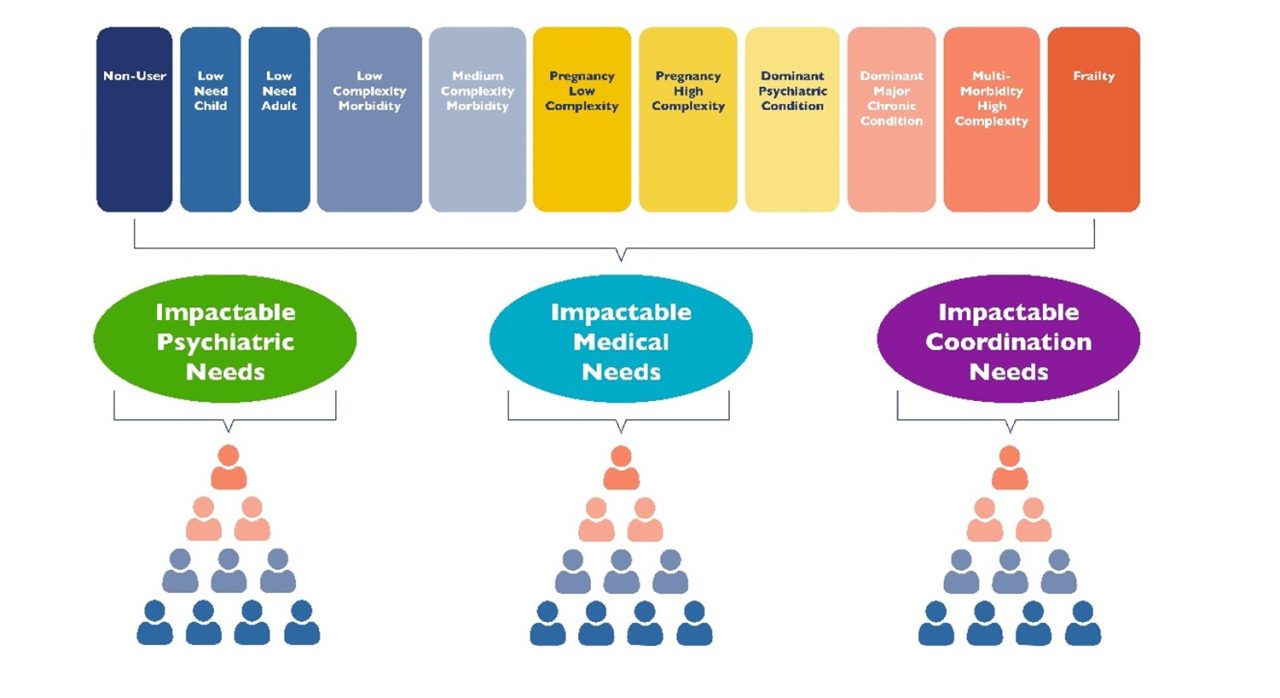

The ACG System has many features to help users understand their population on a deep and complex level. The System can uncover the full scope of a person’s potential health risks, outside factors that influence their well-being and identify opportunities to improve care. Layering these ACG System features allows for a deeper understanding of the complex health needs of a population and allows users to identify groups of impactable patients with opportunities for action.
When assessing an overall population, focusing first on one analysis, then laying in other features, will allow ACG users to explore specific populations and gain deeper levels of understanding. Many features of the ACG System can be layered, allowing users to explore and refine populations for intervention. As an example, segmenting patients based on their risk of admission then stratifying based on RUB score helps users pinpoint high utilizers with a high likelihood of a hospital visit. Alternatively, segmenting patients using ACG GeoHealth markers then overlaying chance of readmission and a recent hospital admission will create a list for a readmission prevention methodology. Below, we describe how to segment and stratify your population to identify high-risk patients with impactable health need.
Within the ACG System, patients are assigned to one of 11 categories called Patient Need Groups (PNGs). This grouping ensures patients aren’t reduced to just one disease they have (heart failure) or one incident (a hospital readmission). PNGs consider the whole person and their medical history, among several factors. This allows providers to see the complete picture of a population on a spectrum of health need in order to prioritize patients and provide appropriate high-quality care or plan interventions.
As patients move through the PNG scale throughout their life, the ACG System tracks the level of need that is required for patients and assigns them a group appropriate to their current and future predicted level of health need. This feature creates a population health assessment to see where your patients with the highest level of need are located so you can apply actionable interventions, as shown in the image below.

Care Modifiers are a proprietary feature within the ACG System that identifies an individual’s traits with actionable opportunities for intervention. For every impactable factor, there is an opportunity to improve care.
Patients using tobacco can benefit from participating in a smoking cessation program. Those with impactable cardiometabolic risk factors, such as hyperlipidemia or pre-diabetes, have opportunities for intervention to improve their care and quality of life. Patients with severe polypharmacy (or the simultaneous use of multiple prescription drugs) can benefit from a de-prescribing initiative. By addressing these actionable concerns, providers and patients can see meaningful improvement in overall patient health.
Risk stratification helps users understand predicted risk for a certain time period. From cost to in-patient admission to readmission, risk stratification within the ACG System predicts which patients are likely to have health challenges in the future. This enables providers to determine appropriate interventions to help the patients avoid these outcomes.
Risk stratification benefits providers and health systems in terms of health outcomes and cost. Controlling cost means controlling unnecessary care, and vice versa. Providers can identify a patient at-risk before the event happens. This not only helps patients live healthier lives with better outcomes, but avoids high costs for all parties.
When users layer these ACG System features, they’re able to see factors which can have an immediate impact on patient health. Providers can not only understand the level of health need among their population through the PNG segmentation methodology, but can also pinpoint patients with actionable opportunities through Care Modifiers and further stratify those at highest risk for negative outcomes. Through this layered approach, we can take an entire patient population down to a smaller impactable population and develop strategies to help those patients live healthier, happier lives with better outcomes and lower cost.
For more information on our full scope of analytics, please email us at info@hopkinsACG.org. If you are an existing ACG System customer, please contact your account manager.
Follow Us